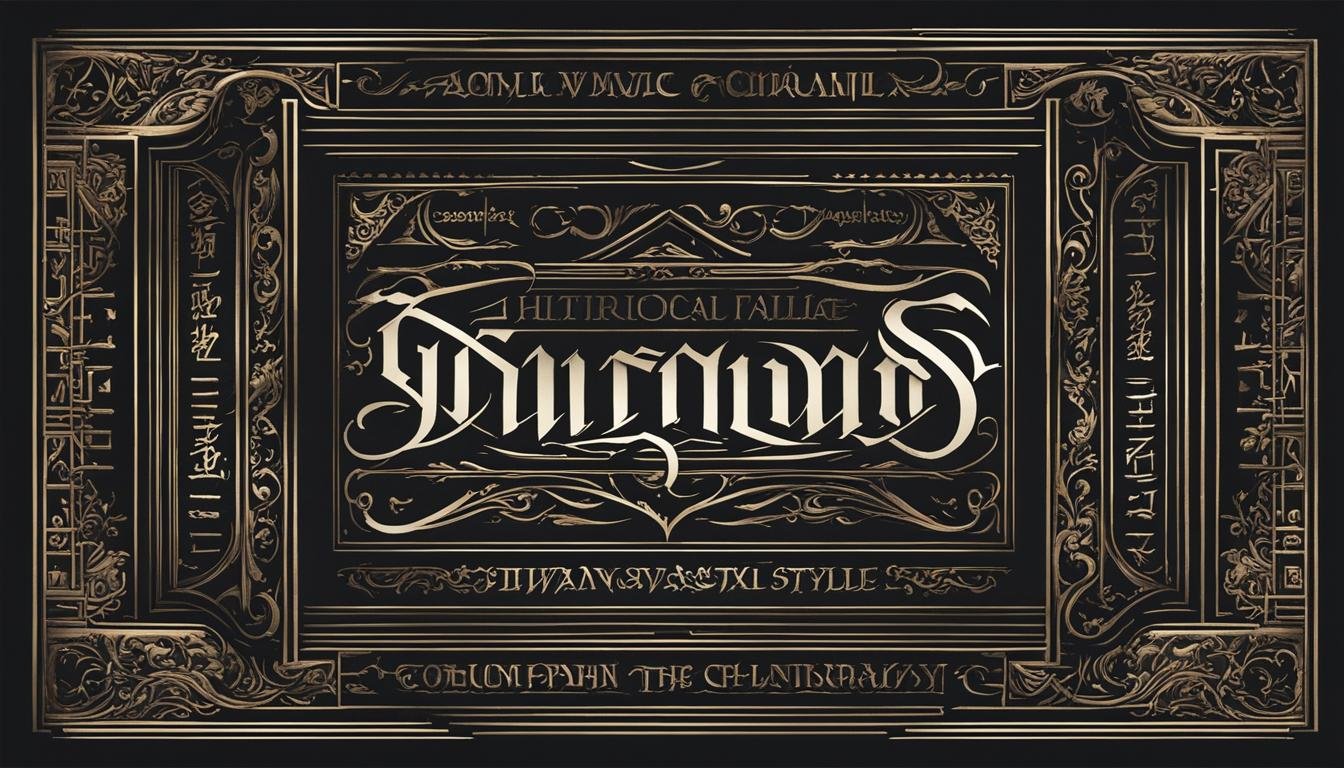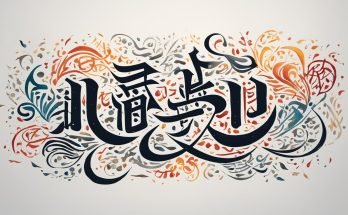Historical Script Styles: Unearth the Fascinating Journey of Calligraphy Through Time!
Historical Script Styles Calligraphy is a beautiful art form that has evolved over centuries, with its roots in ancient civilizations like Egypt, Mesopotamia, and China. The term “calligraphy” comes from the Greek words meaning “beautiful writing,” and it encompasses a wide range of styles and types from Western, Chinese, Japanese, Arabic, Indian, Persian, Tibetan, Korean, Hebrew, and Latin calligraphy. Today, calligraphy is still used in formal invitations, branding, packaging, and as a form of artistic expression.
- Calligraphy has a rich history dating back to ancient civilizations.
- The word “calligraphy” means beautiful writing.
- Calligraphy styles have evolved over time and across different cultures.
- Modern calligraphy allows for more freedom and experimentation.
- Calligraphy continues to be practiced and appreciated today.
The Meaning of the Word Calligraphy
Calligraphy, derived from the Greek words for beauty and writing, carries a deeper significance beyond its literal meaning of “beautiful writing.” It is a form of art that combines creativity, craftsmanship, and emotional expression. Calligraphy goes beyond mere handwriting, incorporating elements such as proportion, space, depth perception, light, and artistic flair. It is a meticulous practice that requires patience, skill, and a deep understanding of the tools and techniques involved.
Calligraphy has been an integral part of cultures around the world for centuries. It has evolved and adapted to various styles and forms, reflecting the unique characteristics of different societies. From the intricate brushstrokes of Chinese calligraphy to the elegant scripts of Western calligraphy, each style carries with it its own historical and cultural significance.
Through calligraphy, artists can convey beauty, meaning, and emotion in a way that transcends everyday writing. It is a timeless art form that continues to captivate and inspire people today. Whether you’re a calligraphy enthusiast or simply appreciate the beauty of the written word, exploring the meaning and history of calligraphy can deepen your understanding and appreciation for this ancient art.
“Calligraphy is not just about writing beautifully; it is about creating an emotional connection through the written word.” – Unknown
The Artistry of Calligraphy
Calligraphy is both a skill and an art. It requires precision, attention to detail, and a keen eye for aesthetics. Each stroke, curve, and loop is carefully crafted to create harmonious letterforms that convey both meaning and beauty. Calligraphers often spend years honing their skills and mastering the techniques of their chosen script.
However, calligraphy is not limited to traditional scripts and styles. Modern calligraphy has emerged as a vibrant and dynamic form of expression, allowing artists to experiment with new letterforms, tools, and styles. It blends traditional calligraphy techniques with contemporary influences, resulting in a unique fusion of the old and the new.
Whether you’re drawn to the elegance of traditional scripts or the expressive freedom of modern calligraphy, the artistry of calligraphy offers endless opportunities for creativity and personal expression.
| Traditional Calligraphy Scripts | Modern Calligraphy Styles |
|---|---|
| Gothic | Brush Calligraphy |
| Italic | Watercolor Lettering |
| Uncial | Typography Calligraphy |
Whether you’re an aspiring calligrapher or an admirer of the art form, the meaning of calligraphy extends far beyond its literal definition. It represents a fusion of skill, beauty, and creativity, inviting us to explore the possibilities of the written word.
Calligraphy Through the Years
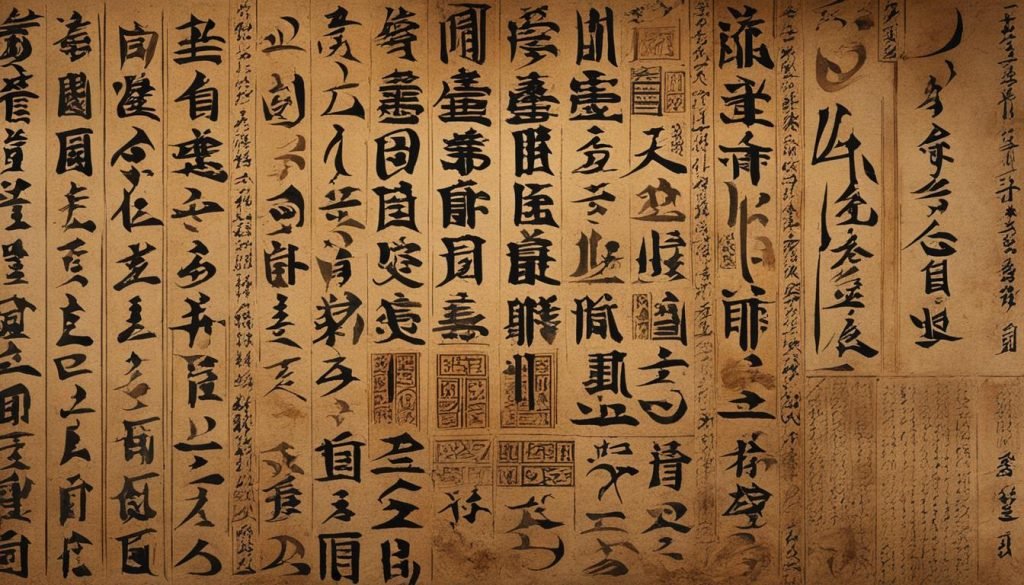
Calligraphy, as an art form, has a fascinating history that spans centuries and continents. It has gone through various stages of evolution, adapting to different cultural influences and technological advancements. From its humble beginnings as pictograms and ideographs in ancient civilizations like Egypt and Mesopotamia, calligraphy has transformed into intricate scripts and writing systems in China, Europe, and beyond. Let’s explore the evolution of calligraphy and delve into its rich history.
Evolution of Calligraphy
In ancient Egypt, calligraphy began with hieroglyphs, a system of symbols that represented sounds and concepts. These hieroglyphs gradually developed into more refined scripts, such as hieratic and demotic, which were used for everyday writing. Similarly, in Mesopotamia, cuneiform writing emerged as one of the earliest forms of writing, consisting of wedge-shaped marks pressed into clay tablets. These early scripts laid the foundation for calligraphy as an artistic form of expression.
In China, calligraphy has been considered a highly respected art form for thousands of years. It involves using a brush and ink to create strokes and characters, with an emphasis on the balance, rhythm, and flow of each stroke. Chinese calligraphy encompasses different styles such as seal script, clerical script, regular script, running script, and cursive script. Each style has its own unique characteristics and historical significance, reflecting the cultural and artistic development of China over the centuries.
In Europe, calligraphy took various forms throughout history. The Gothic script, characterized by its intricate and angular letters, dominated during the Middle Ages. The Renaissance period brought a revival of classical styles, with greater emphasis on proportion, symmetry, and beauty. With the invention of the printing press in the 15th century, the popularity of handwritten books declined, but calligraphy continued to be practiced by scribes and monks. In modern times, calligraphy has experienced a resurgence as artists explore new styles, techniques, and mediums.
| Region | Example Scripts |
|---|---|
| Egypt | Hieroglyphs, Hieratic, Demotic |
| Mesopotamia | Cuneiform |
| China | Seal script, Clerical script, Regular script, Running script, Cursive script |
| Europe | Gothic script, Renaissance script |
These are just a few examples of the diverse range of calligraphy styles and scripts that have developed over time. Each region and culture has contributed to the evolution of calligraphy, adding new techniques, tools, and artistic expressions to the art form.
As calligraphy continues to evolve, it remains a timeless and cherished form of visual communication. Whether used in formal invitations, branding, packaging, or as a personal artistic expression, calligraphy embodies the beauty and skill of handwriting. It is a testament to the human ability to transform mere words into works of art.
Calligraphy Hand Categories and Scripts
Calligraphy scripts can be classified into different hand categories, each with its own unique characteristics and historical context. These categories represent the various styles used throughout history, showcasing the evolution of calligraphy across different regions and time periods.
1. Roman and Late Roman Scripts
In the Roman and late Roman script category, several styles were prevalent. These include Imperial Capitals, Rustic Capitals, and Square Capitals. These scripts were characterized by their bold letterforms and distinct architectural style, often used for inscriptions and monumental purposes.
2. Insular and National Scripts
In the Insular and National script category, Insular Majuscules and Insular Minuscule were prominent. These scripts emerged in the British Isles and were influenced by Celtic and Irish artistic traditions. Insular scripts were known for their intricate knotwork and highly decorative letterforms.
3. Caroline and Early Gothic Scripts
The Caroline and Early Gothic script category included Caroline Minuscules and Early Gothic scripts. Caroline Minuscules, developed during the Carolingian period, featured more rounded and legible letterforms. Early Gothic scripts, such as Textura Quadrata and Textura Prescisus, emerged in the 12th century and were characterized by their dense, vertical strokes.
4. Gothic Scripts
Gothic scripts encompass a range of styles, including Textura Quadrata, Textura Prescisus, Gothic Capitals, Lombardic Capitals, Bastard Secretary, Bâtarde, and Fraktur. These scripts were widely used in Europe from the 13th to the 15th century and are known for their intricate details, sharp serifs, and vertical emphasis.
5. Italian and Humanist Scripts
Italian and humanist scripts include Rotunda, Rotunda Capitals, Humanist Minuscule, Italic, and Humanist Capitals. These scripts emerged during the Italian Renaissance and were influenced by classical Roman letterforms. Italian scripts are known for their elegant and flowing curves, while humanist scripts emphasized legibility and clarity.
6. Post-Renaissance Scripts
Post-Renaissance scripts feature Copperplate and Copperplate Capitals. Copperplate script, developed in the 17th century, is characterized by its elegant and elaborate cursive style. It became popular for formal documents, invitations, and certificates due to its refined appearance.
These calligraphy hand categories and scripts showcase the diversity and historical significance of calligraphy as an art form. Each style has its own unique characteristics, techniques, and cultural context, contributing to the richness of calligraphic traditions.
| Hand Category | Script Styles |
|---|---|
| Roman and Late Roman | Imperial Capitals, Rustic Capitals, Square Capitals |
| Insular and National | Insular Majuscules, Insular Minuscule |
| Caroline and Early Gothic | Caroline Minuscules, Early Gothic |
| Gothic | Textura Quadrata, Textura Prescisus, Gothic Capitals, Lombardic Capitals, Bastard Secretary, Bâtarde, Fraktur |
| Italian and Humanist | Rotunda, Rotunda Capitals, Humanist Minuscule, Italic, Humanist Capitals |
| Post-Renaissance | Copperplate, Copperplate Capitals |
These hand categories and scripts provide a glimpse into the historical development of calligraphy and the diverse styles that emerged across different cultures and time periods. Through the mastery of these scripts, calligraphers were able to create stunning works of art that continue to inspire and captivate audiences to this day.
The Evolution of Letterforms

One of the fascinating aspects of calligraphy is the evolution of letterforms over time. As calligraphy developed in different cultures and artistic movements, the shapes and styles of letters underwent significant transformations. These changes were influenced by factors such as the available tools, cultural preferences, and the artistic vision of calligraphers.
During the Celtic and Gothic periods, calligraphers worked with small pens made of feather quills, resulting in intricate and delicate letterforms. The Renaissance period brought a revival of classical inspiration, with calligraphers drawing inspiration from carved capitals and pen capitals. The invention of movable type and the printing press brought a shift in the role of calligraphy, but it continued to be practiced and appreciated.
“The evolution of letterforms in calligraphy showcases the ingenuity and adaptability of the art form. From the small, intricate letters of religious manuscripts to the elegant and flowing copperplate script, calligraphers have constantly pushed the boundaries of letter design.”
Table: Evolution of Calligraphy Letterforms
| Period | Letterforms | Description |
|---|---|---|
| Celtic and Gothic | Intricate and delicate | Small pens made of feather quills |
| Renaissance | Classical inspiration | Inspired by carved capitals and pen capitals |
| Movable Type Era | Printing press influence | Shift in the role of calligraphy |
One influential figure in the evolution of calligraphy letterforms is Edward Johnston, who developed the Foundational Hand. This script played a significant role in defining the mechanics of calligraphy and set the foundation for modern calligraphy styles. Johnston’s work influenced countless calligraphers and continues to inspire new generations.
Modern calligraphy has further expanded the possibilities of letterforms, allowing artists and calligraphers to experiment with new styles, strokes, and tools. The combination of traditional techniques and contemporary artistic expression has resulted in a vibrant and diverse range of letterforms in modern calligraphy.
The evolution of letterforms in calligraphy reflects the ever-changing nature of art and design. It demonstrates the creative innovation of calligraphers throughout history and showcases the timeless beauty of this ancient art form.
The History of Copperplate
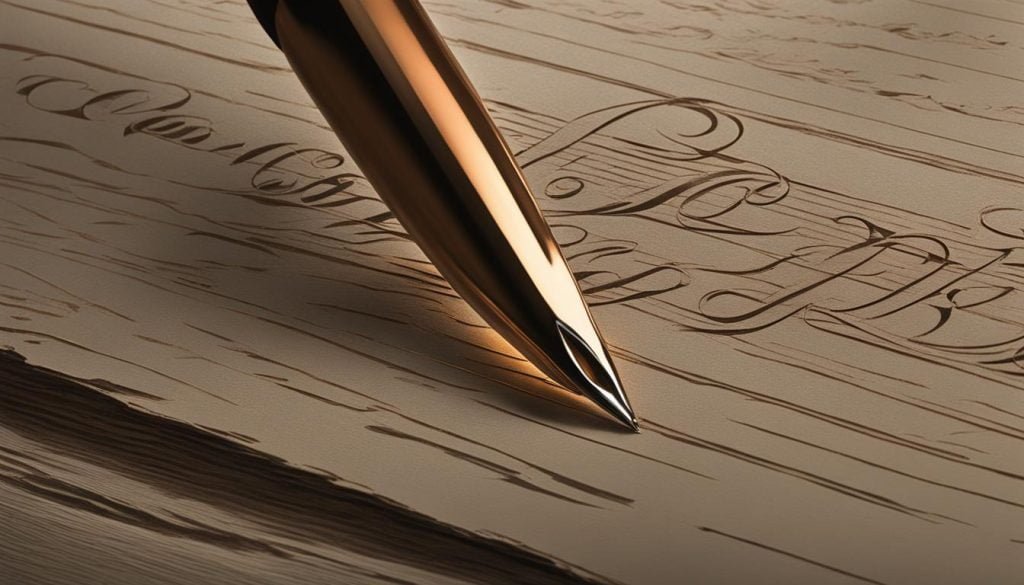
Copperplate is a style of calligraphy that emerged in the 17th century, characterized by its extreme cursive script and linked letters. It takes its name from copperplate engraving, a popular technique during that time. The elegance and versatility of Copperplate script quickly made it widely practiced and appreciated.
Although Copperplate calligraphy was prominent during the 17th century, its roots can be traced back to the Italian Renaissance. The script was highly influenced by the stylish handwriting of Italian scribes, who used a pointed metal nib to create the fluid, interconnected letters.
As one of the most ornate and decorative calligraphy styles, Copperplate is often associated with formal and elegant occasions. It is commonly used for formal invitations, certificates, and other high-end applications where a sophisticated aesthetic is desired.
The Characteristics of Copperplate Calligraphy
“Copperplate calligraphy is known for its flowing, delicate lines and highly connected letters. The script is written with a pointed pen, which allows for both thick and thin strokes, creating a visual contrast on the page.”
The slanted letterforms of Copperplate calligraphy give it a graceful and dynamic appearance. The script requires a high level of control and precision to achieve the desired effect, making it a favorite among skilled calligraphers.
In recent years, Copperplate calligraphy has experienced a resurgence in popularity, as more people embrace the beauty and craftsmanship of traditional handwriting. It continues to be practiced by calligraphers and artists around the world, who incorporate modern adaptations and personal styles into their Copperplate creations.
Modern Calligraphy
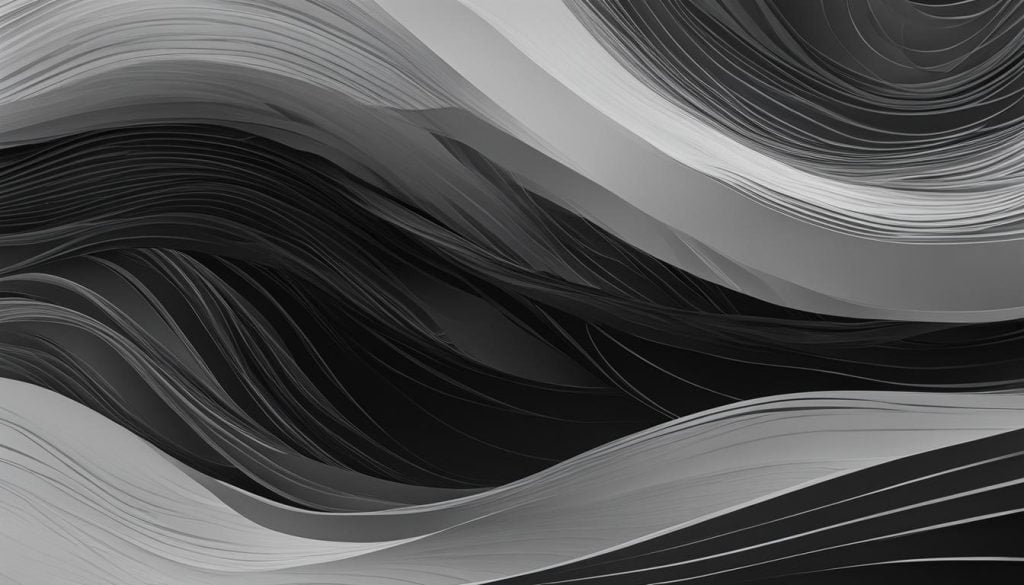
Modern calligraphy is an exciting evolution of traditional calligraphy styles, offering a fresh and contemporary approach to this timeless art form. It combines the fundamentals of calligraphy with personal creativity and expression, allowing artists to explore new letterforms, techniques, and tools.
Unlike traditional calligraphy scripts that follow strict rules and structures, modern calligraphy embraces a more relaxed and experimental approach. Artists have the freedom to play with letter shapes, sizes, and connections, creating unique and dynamic compositions. This versatility has made modern calligraphy a popular choice among designers, artists, and individuals looking to add a touch of elegance to their projects.
One of the defining characteristics of modern calligraphy is the use of a variety of writing instruments. While traditional calligraphy typically relies on dip pens and brushes, modern calligraphers often explore different tools like brush pens, markers, or even unconventional materials to achieve their desired effects.
With modern calligraphy, there are endless possibilities for creativity and self-expression. Whether you’re a beginner or an experienced calligrapher, exploring modern calligraphy can be a rewarding journey that allows you to develop your own unique style and leave your mark on the world.
Styles of Modern Calligraphy
Modern calligraphy encompasses a variety of styles, each with its own distinct characteristics and aesthetics. Some popular styles include:
- Brush Calligraphy: Using a brush pen or brush tool to create bold and expressive letterforms.
- Watercolor Calligraphy: Combining calligraphy with watercolor painting to create beautiful and vibrant compositions.
- Digitized Calligraphy: Creating calligraphy digitally using graphic design software and tablets.
- Flourished Calligraphy: Adding decorative flourishes and embellishments to letterforms, creating an elegant and ornate look.
These are just a few examples, and modern calligraphy allows for endless experimentation and innovation. It’s an exciting time to explore this art form and discover your own unique voice within the world of calligraphy.
The Different Types of Calligraphy
If you’re fascinated by the art of calligraphy, you’ll be delighted to discover the wide array of calligraphy styles from around the world. Each type of calligraphy has its own unique characteristics and techniques, making it a rich and diverse art form to explore.
Let’s take a closer look at some of the most prominent calligraphy styles:
Western Calligraphy
- Gothic: Known for its intricate and ornate letterforms, Gothic calligraphy originated in Europe during the medieval period.
- Italic: Derived from the Renaissance period, Italic calligraphy features elegant and flowing letterforms.
- Uncial: This ancient form of calligraphy is characterized by its rounded and uniform letterforms.
- Copperplate: With its highly cursive script and intricate letterforms, Copperplate calligraphy became popular in the 17th century.
Chinese Calligraphy
- Regular Script: Also known as Kaishu, this style is characterized by its balanced and symmetrical letterforms.
- Running Script: Known as Xingshu, Running Script combines elements of cursive and regular script, resulting in a more fluid and dynamic style.
- Cursive Script: Referred to as Caoshu, Cursive Script features highly simplified and connected letterforms, creating a sense of energy and spontaneity.
- Seal Script: Used primarily for seals and stamps, Seal Script is a highly stylized form of calligraphy that evolved from ancient Chinese characters.
Arabic Calligraphy
- Naskh: Known for its legibility and rounded letterforms, Naskh is one of the most widely used calligraphy styles in the Islamic world.
- Thuluth: With its elongated and elegant letterforms, Thuluth calligraphy is often used for decorative purposes.
- Diwani: This intricate and ornamental style of calligraphy is characterized by its flowing and interconnected letters.
These are just a few examples of the many types of calligraphy styles that exist. Each style has its own rich history, techniques, and cultural significance. Whether you’re a beginner or an experienced calligrapher, exploring the diverse world of calligraphy can open up a world of artistic possibilities.
Is Calligraphy Still Used Today?
Despite the prevalence of digital communication and printing technology, calligraphy continues to be used in various ways today. Its timeless beauty and personal touch make it a popular choice for special occasions, branding, and artistic expression.
One of the most common uses of calligraphy today is in formal invitations. Whether it’s a wedding, anniversary, or other special event, calligraphy adds an elegant and personalized touch to the invitation. The carefully crafted letterforms and unique ink colors create a luxurious and memorable experience for the recipient.
Businesses and organizations also recognize the value of calligraphy in branding. By incorporating calligraphy into logos, packaging, and other visual elements, companies can create a distinctive and memorable identity. Calligraphy conveys a sense of craftsmanship, attention to detail, and authenticity, which can resonate with customers and enhance brand recognition.
Calligraphy is not limited to traditional applications. Many artists and designers explore calligraphy as a form of artistic expression. By blending traditional techniques with contemporary styles and mediums, they create stunning visual art pieces that capture the essence of calligraphy while pushing the boundaries of creativity.
| Use of Calligraphy Today | Examples |
|---|---|
| Formal Invitations | Wedding invitations, event announcements |
| Branding | Logos, packaging |
| Artistic Expression | Visual art pieces, calligraphy fusion |
In addition to these practical applications, calligraphy workshops and classes are available for individuals who want to learn and develop their own calligraphic skills. These educational opportunities not only keep the art of calligraphy alive but also provide a community for enthusiasts to connect, share ideas, and inspire one another.
Calligraphy may have evolved over time, adapting to changes in technology and artistic trends, but its enduring appeal and versatility ensure its continued relevance in the modern age.
Calligraphy Tools: Essential Equipment for Aspiring Calligraphers
If you’re captivated by the artistry of calligraphy and eager to try your hand at this beautiful craft, it’s essential to have the right tools at your disposal. From nibs to ink and paper, each element plays a crucial role in creating stunning letterforms and achieving the desired effects. In this section, we’ll explore the essential tools that every aspiring calligrapher should have in their arsenal.
Pens and Nibs
A pen or nib is the primary tool used in calligraphy to create strokes and letterforms. There are various types of nibs available, each offering a unique writing experience and producing different line variations. The most common types of nibs include pointed nibs for delicate, precise work and broad-edged nibs for wider strokes and letterforms. It’s important to experiment with different nibs to discover your preferred style and achieve the desired results.
Ink and Paper
Choosing the right ink and paper is crucial for creating beautiful calligraphy. Ink comes in various forms, including bottled ink, ink cartridges, and ink sticks. Bottled ink is versatile and allows for customization, while ink cartridges offer convenience and ease of use. Ink sticks are used in traditional Asian calligraphy and require grinding with water to produce ink.
When it comes to paper, selecting a suitable option is equally important. Smooth, high-quality paper is recommended for practicing calligraphy, as it allows the ink to flow smoothly and prevents any bleeding or smudging. Experiment with different types of paper to find the one that best suits your preferred calligraphy style.
Additional Tools
While pens, nibs, ink, and paper are the core components of a calligrapher’s toolkit, there are other tools that can enhance your calligraphy experience. These include rulers for precise measurements and straight lines, erasers and correction fluid for fixing mistakes, brushes for more expressive and artistic calligraphy styles, and drying racks to prevent smudging while your work dries. Additionally, illumination materials such as gold leaf or pigments can be used to add decorative touches to your calligraphy.
By equipping yourself with the essential tools of the trade, you’ll be well-prepared to embark on your calligraphy journey. Remember, practice and experimentation are key to honing your skills and developing your own unique calligraphy style. So, gather your tools, find inspiration, and let your creativity flourish as you explore the world of calligraphy.
Evolution of Calligraphy: A Journey through History
Calligraphy has undergone a fascinating evolution throughout history, adapting and transforming alongside the cultures, technologies, and artistic movements that have influenced it. From its ancient origins to its modern interpretations, calligraphy has remained an enduring and cherished form of visual communication.
In ancient civilizations such as Egypt, Mesopotamia, and China, calligraphy emerged as a way to transform writing into an art form. Scripts like Western, Chinese, Japanese, Arabic, and Latin calligraphy developed, each with its own unique style and cultural significance. Over time, calligraphy became a prominent feature of formal invitations, branding, packaging, and artistic expression.
The invention of the printing press in the 15th century brought a shift in the role of calligraphy, as handwritten books declined in popularity. However, calligraphy continued to be practiced by monks and scribes, preserving its traditions. In the 20th century, calligraphy experienced a resurgence as artists and designers incorporated handcrafted elements into their work, blending traditional techniques with contemporary styles.
The Rise of Modern Calligraphy
Modern calligraphy emerged as a style that broke away from the strict rules and structures of traditional calligraphy scripts. It allowed for greater freedom and experimentation with letterforms, strokes, and tools. Modern calligraphers combined traditional calligraphy with contemporary artistic expression, resulting in unique and personalized creations.
| Traditional Calligraphy | Modern Calligraphy |
|---|---|
| Follows strict rules and structures | Allows for more freedom and experimentation |
| Emphasizes precision and craftsmanship | Focuses on artistic expression and creativity |
| Rooted in historical scripts and cultural traditions | Blends traditional calligraphy with contemporary styles |
“Modern calligraphy represents a fusion of tradition and innovation, allowing artists to push the boundaries of what is possible in the world of calligraphy.”
Today, calligraphy continues to evolve as artists experiment with new styles, techniques, and tools. It remains a timeless and cherished art form that captivates people from all walks of life. Whether you’re a beginner or an experienced calligrapher, exploring the rich history and diverse styles of calligraphy can deepen your appreciation for this ancient craft.
Conclusion – Historical Script Styles
Calligraphy is a timeless art form that has truly stood the test of time. From its ancient origins to modern interpretations, calligraphy continues to captivate and inspire people around the world. The rich history and diverse styles of calligraphy offer endless possibilities for both beginners and experienced calligraphers to explore and create.
Despite the digital age, calligraphy still holds a special place in our lives. It adds elegance and personalization to formal invitations and branding, and it allows artists to express their creativity and emotions through beautifully formed letterforms. This ancient art form has adapted and evolved, embracing new technologies and artistic movements throughout the centuries.
Whether you’re a calligraphy enthusiast or simply someone who appreciates the beauty of the written word, exploring the world of calligraphy can be a rewarding journey. So grab your pens, brushes, and paper, and let your creativity flow as you delve into the rich history and diverse styles of calligraphy.
FAQ – Historical Script Styles
What is calligraphy?
Calligraphy is a beautiful art form that involves creating visually appealing and expressive writing using various styles and types of lettering.
What is the meaning of the word calligraphy?
The word “calligraphy” comes from the Greek words meaning “beautiful writing.”
How has calligraphy evolved over time?
Calligraphy has evolved and adapted to different cultures, languages, and artistic styles, from its origins in ancient civilizations to the development of various script styles around the world.
What are the different hand categories in calligraphy?
Calligraphy scripts can be categorized into different hand categories, such as Roman and late Roman scripts, Insular and National scripts, Caroline and Early Gothic scripts, Gothic scripts, Italian and humanist scripts, and Post-Renaissance scripts.
How have letterforms evolved in calligraphy?
Throughout history, letterforms in calligraphy have evolved and adapted to different cultures, languages, and artistic styles, from Celtic scribes and Gothic calligraphers to the classical inspiration of the Renaissance period.
What is the history of Copperplate in calligraphy?
Copperplate is a calligraphy style that emerged in the 17th century and is characterized by its extreme cursive script. It became prevalent due to its elegance and versatility.
What is modern calligraphy?
Modern calligraphy refers to a style of calligraphy that does not follow the strict rules and structures of traditional calligraphy scripts. It allows for more freedom and experimentation with letterforms, strokes, and tools.
What are the different types of calligraphy?
Calligraphy encompasses a wide range of styles and types from various cultures around the world, including Western, Chinese, Japanese, Arabic, Indian, Persian, Tibetan, Korean, Hebrew, and Latin calligraphy.
Is calligraphy still used today?
Yes, calligraphy is still commonly used today in formal invitations, branding, packaging, and as a form of artistic expression.
What tools are used for calligraphy?
Some common tools used in calligraphy include nibs, pen holders, ink, paper, brushes, rulers, erasers, correction fluid, drying racks, and illumination materials like gold leaf or pigments.
How has calligraphy evolved over time?
Calligraphy has evolved over time, adapting to different cultures, technologies, and artistic movements. From its origins in ancient civilizations to the modern era, calligraphy continues to evolve as artists experiment with new styles, techniques, and tools.

